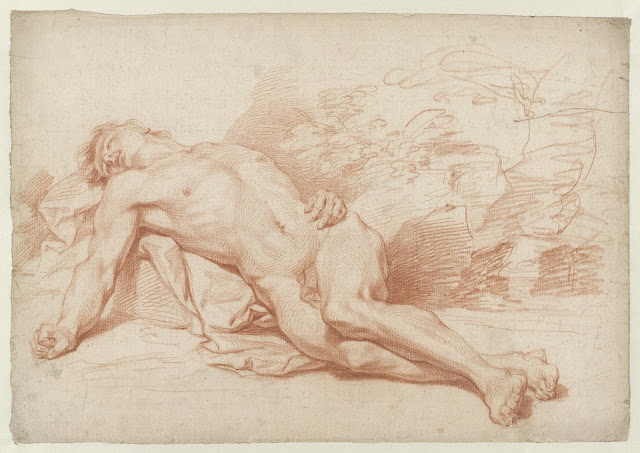 |
| Giuseppe Passeri Portrait sketch of a young man ca. 1703-1713 drawing Rijksmuseum, Amsterdam |
 |
| Carel de Moor Head of a young woman before 1738 etching Rijksmuseum, Amsterdam |
 |
| Gilles Demarteau Studies of noses (drawing manual) before 1776 etching Rijksmuseum, Amsterdam |
My Century
The year I was born the atomic bomb went off.
Here I'd just begun, and someone
found the switch to turn off the world.
In the furnace-light, in the central solar fire
of that heat lamp, the future got very finite,
and it was possible to imagine time-travelers
failing to arrive, because there was no future.
Inside the great dark clock in the hall,
heavy brass cylinders descended.
Tick-tock, the chimes changed their tune
one phrase at a time. The bomb became
a film star, its glamorous globe of smoke
searing the faces of men in beach chairs.
Someone threw up every day at school.
No time to worry about collective death,
when life itself was permeated by ordeals.
And so we grew up, beneath an umbrella of acceptance.
In bio we learned there were particles
cruising through us like whales through archipelagoes,
and in civics that if Hitler had gotten the bomb
he'd have used it on the inferior races,
and all this time love was etching its scars
on our skins like maps. The heavens
remained pure, except for little white slits
on the perfect blue skin that planes cut
in the icy upper air, like needles sewing.
From one, a tiny seed might fall
that would make a sun on earth.
And so the century passed, with me still in it,
books waiting on the shelves to become cinders,
what we felt locked up inside, waiting to be read,
down the long corridor of time. I was born
the year the bomb exploded. Twice
whole cities were charred like cities in the Bible,
but we didn't look back. We went on thinking
we could go on, our shapes the same,
darkened now against a background lit by fire.
Forgive me for doubting you're there,
Citizens, on your holodecks with earth wallpaper –
a shadow-toned ancestor with poorly pressed pants,
protected like a child from knowing the future.
– Alan Feldman (2001)
 |
| Mattheus Verheyden Study of left hand 1744 drawing Rijksmuseum, Amsterdam |
 |
| Mattheus Verheyden Study of left hand ca. 1740-50 drawing Rijksmuseum, Amsterdam |
 |
| Mattheus Verheyden Study of right hand ca. 1740-50 drawing Rijksmuseum, Amsterdam |
 |
| Mattheus Verheyden Study of right hand ca. 1740-50 drawing Rijksmuseum, Amsterdam |
 |
| circle of François Boucher Académie ca. 1750 drawing Rijksmuseum, Amsterdam |
Rain Effect
A bride and a groom sitting in an open buggy
in the rain, holding hands but not looking
at each other, waiting for the rain to stop,
waiting for the marriage to begin, embarrassed
by the rain, the effect of the rain on the bridal
veil, the wet horse with his mane in his eyes,
the rain cold as the sea, the sea deep as love,
big drops of rain falling on the leather seat,
the rain beaded on a rose pinned to the groom's
lapel, the rain on the bride's bouquet,
on the baby's breath there, the sound of the rain
hitting the driver's top hat, the rain
shining like satin on the black street,
on the tips of patent leather shoes, Hokusai's
father who polished mirrors for a living, Hokusai's
father watching the sky for clouds, Hokusai's father's son
drawing rain over a bridge and over the people crossing
the bridge, Hokusai's father's son drawing the rain
for hours, Hokusai's father rubbing a mirror, the rain
cold as the sea, the sea cold as love, the sea swelling
to a tidal wave, at the tip of the wave white.
– Mary Ruefle (1996)
 |
| Cornelis Joseph d'Heur Académie before 1762 drawing Rijksmuseum, Amsterdam |
 |
| Cornelis Joseph d'Heur Académie before 1762 drawing Rijksmuseum, Amsterdam |
 |
| Cornelis Joseph d'Heur Académie before 1762 drawing Rijksmuseum, Amsterdam |
 |
| Louis Fabritius Dubourg Academic models posed as combatants 1728 drawing Rijksmuseum, Amsterdam |
 |
| Louis Fabritius Dubourg Academic model posed as prisoner 1723 drawing Rijksmuseum, Amsterdam |
 |
| Angelo Bertini after Giovanni Tognolli after Antonio Canova Statue of Hector ca. 1793-1838 engraving Rijksmuseum, Amsterdam |
Poems from the archives of Poetry (Chicago)